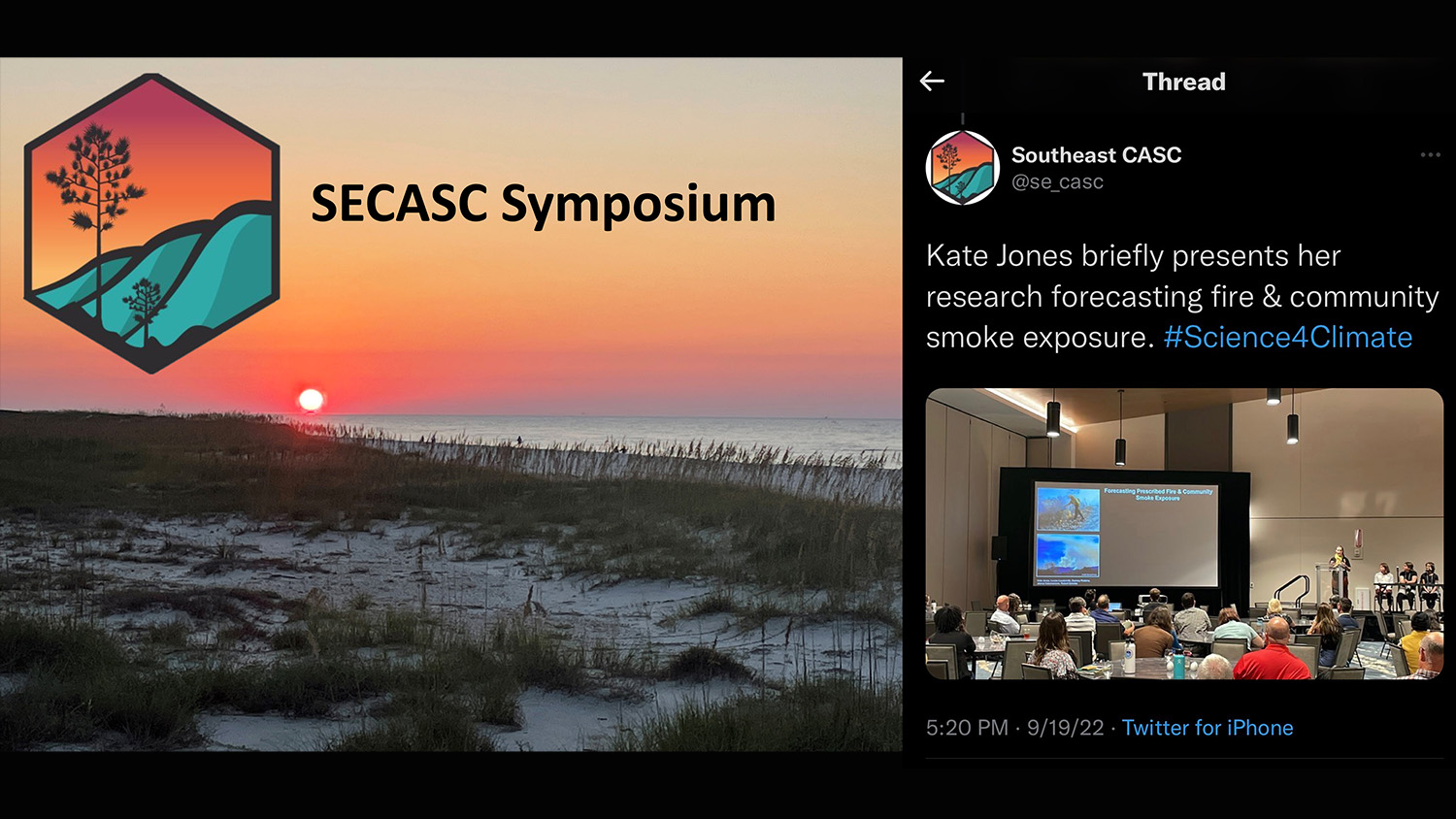Kate Jones, Former Global Change Fellow, Reflects on the 2022 Southeast Climate Adaptation Science Symposium

This post contains an article written by Kate Jones, former Global Change Fellow, for the Center for Geospatial Analytics News website. The following is a personal reflection of her experience at the 2022 Southeast Climate Adaptation Science Symposium and as a Global Change Fellow. View the post here.
Connecting Southeast Scientists, Managers, Educators and Students
Editor’s note: Each semester, students in the Geospatial Analytics Ph.D. program can apply for a Geospatial Analytics Travel Award that supports research travel or presentations at conferences. The following is a guest post by travel award winner Kate Jones as part of the Student Travel series.
As a graduate student, it is rare to be surrounded by a blend of researchers, practitioners, teachers and other students all committed to advancing actionable climate science and adaptation. The Southeast Climate Adaptation Science Center (SECASC) Symposium provides just that environment. Nearly 200 people with an interest in climate-adaptive natural resource management gathered at The Lodge at Gulf State Park in Gulf Shores, AL, this September to share new research, provide updates on project successes and road blocks, and participate in a collective whole working towards advancing climate education, equity, research methods and management practices.
The Lodge and its interpretive center are seeking LEED Platinum certification and are an internationally acclaimed destination for sustainable tourism. The Lodge was constructed with federal and state funds following the Deepwater Horizon oil spill; prior to construction, there was an extensive community engagement process aimed at incorporating community values (access, connectivity, conservation, etc.) and improvements to Gulf State Park.
The symposium host, SECASC, is headquartered at NC State and is a member of the larger United States Geological Survey (USGS) National CASC network, made up of eight other regional CASCs. Other universities in the SECASC include Auburn University, Duke University, University of Florida, University of South Carolina and University of Tennessee. The collective research priorities of SECASC and its member universities are 1) Exposure: Improve partner understandings of identifying climate change in their managed areas, 2) Impacts: Improve partner understanding of impacts, specifically focused on partner resources of interest, 3) Adaptation: Increase awareness and access to climate-adaptive planning resources.
In addition to guiding research priorities, largely funded by the USGS and consortium universities, SECASC also funds the Global Change Fellows Program for graduate students at NC State. I participated as a Global Change Fellow in 2019 as a first-year Ph.D. student. My experience in the program, specifically attending the 2019 SECASC Symposium in New Orleans, LA, shaped the trajectory of my dissertation and provided my first exposure to such a vibrant community of researchers and managers co-producing and sharing science and adaptive management strategies.
Global Change Fellows participate in a one-year program that provides a field-intensive week-long meeting with natural resource managers in the Southeast, climate science communication workshops, opportunities to engage with academic and federal researchers, and most valuable, a network of graduate students prioritizing similar interdisciplinary research values and ways of working beyond academic silos. The CASC creates an environment where students are invited to engage, share, and learn––even after they’ve moved on from the Global Change Fellows program.
As a previous fellow, I was offered the opportunity to apply for travel funding and share my research at this year’s symposium. I presented a poster and gave a lightning talk with a group of six other former fellows. The research I presented was a direct product of my involvement in the Global Change Fellows program that instilled in me a desire to pursue my own funding from the Joint Fire Sciences Program. (Learn more about that effort to forecast smoke from future prescribed fires.)
Following the lightning talk and during the poster session, I was able to speak with practitioners from the US Fish and Wildlife Service, the National Park Service, several Tribal Nations, and a number of state agencies––all concerned about the future of people interacting with wildland fire smoke. As I enter the last year (?) of my Ph.D., I welcomed the reinvigorating conversation and the chance to connect with individuals asking similar questions and tackling smoke management concerns on the ground.
In addition to sharing my own research, I worked with other former fellows to curate key takeaways from the different breakout sessions. The breakout sessions covered a variety of topics, for example, simulating future weather events under climate change, biological invasions, nature-based solutions for climate adaptation, evolving fire management strategies under future climate, and connecting justice, equity and conservation for climate adaptation across scales. Notetakers worked with the breakout session leads to refine takeaways, which were then shared in a final symposium wrap-up session called Moving Priorities Forward designed to “report out on gaps identified in Breakouts and Combined sessions, connect back to partner perspectives and map to potential science initiatives.”
It was truly wonderful to connect (in-person!) with this community three years after my first SECASC symposium. Participating as a Global Change Fellow is a highlight of my Ph.D. experience, and I look forward to continued involvement with the CASC network.
Sincere thanks to Cari Furiness and Aranzazu Lascurain for truly making the Global Change Fellows program such an unmatched experience and continuing to provide former fellows opportunities and funding to engage with the CASCs. Thank you to CGA’s Robert Scheller and Jelena Vukomanovic, Louise Loudermilk (USFS), and our management partners at The Nature Conservancy, the North Carolina Wildlife Resources Commission, and the Center for Appalachian Fire Managers and Scientists for making possible the work presented at the symposium. Thanks too to Zachary Robbins (Los Alamos National Labs) for his significant contributions to the modeling work, and thank you to the Joint Fire Sciences Program for funding.
- Categories:
